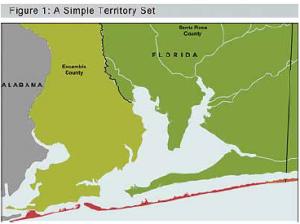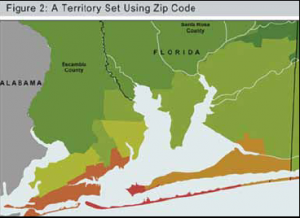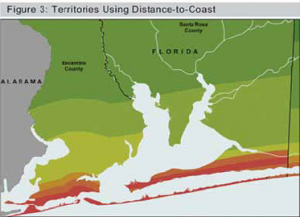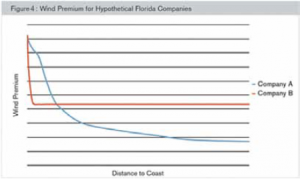Small companies often believe that they do not have enough homeowners data to build custom rating territories based on different perils, and therefore simply adopt the territories of a competitor. But because catastrophe models are fully credible and small companies use the same catastrophe models as large companies, any company can use them to design homogeneous, credible territories.
By “homogeneous” and “credible,” we mean that all risks within the territory should have the same expected loss and that it should be possible to accurately estimate that expected loss. Typically, homeowners territories are designed with non-wind perils in mind, even though the risk from each peril has its own unique geographic distribution.
In most states, the majority of companies do not recognize this. In Florida, however, the wind peril is so important, and its geographic variation so different from non-wind perils, that all companies recognize that rates must be made separately for wind and non-wind.
But despite this recognition, most companies use the same rating territories for wind and non-wind perils. This is a compromise that doesn’t really do justice to either—while the wind peril varies predominantly with the distance to the coast, the non-wind perils vary predominantly with population density and other factors. An ideal rating structure would consist of territories that are different for each.
Current Practice
Most homeowners insurers use one of two approaches for rating territories in Florida. The first approach consists of developing territories that are defined mostly by county boundaries. These territories are defined based on the county and, in some cases, major cities, and are subdivided into a coastal region and an inland region.
Figure 1 (color coded to indicate differences in premiums) shows an example of this approach. This territory scheme does not do a good job of matching premium to underlying risk. Although hurricane risk varies continuously from the coast, decreasing rapidly as one goes farther inland, and more slowly as one travels along the coast, this scheme assumes that risk varies by county and for the mainland versus the barrier islands. A more sophisticated rating scheme would better recognize that risk varies continuously.
The second approach commonly used today is to define territories based on groupings of ZIP codes, as shown in Figure 2. In general, this approach results in more territories than the first. The groupings try to combine ZIP codes that are a similar distance from the coast and in the same geographic region.
Both approaches are intended to combine regions that have similar expected losses, but both approaches have significant shortcomings:
The number of territories is inadequate to accurately differentiate the risk. Simply placing a property on one side of a line or the other results in discontinuities. While wind risk varies continuously, premiums varies vary discontinuously, meaning there are areas that are overpriced and others that are underpriced.
The dividing line between coastal and inland territories is not usually based on a fixed distance from the coast, but rather on geographic features such as the Intracoastal Waterway. Because those features may vary in their distances from the coast, locations that are the same distance from the coast could be assigned to an inland territory or a coastal territory depending on their position relative to this geographic feature. This creates nonhomogeneous territories and provides more sophisticated competitors with marketing opportunities by offering lower rates for risks that have been overpriced.
ZIP codes are defined for the convenience of the post office and have no relation to causes of property loss. They are irregularly shaped, meaning that locations at different points within the same ZIP code may be different distances from the coast. They are too big, resulting in locations with very different risk levels being grouped together. The post office changes ZIP codes over time, introducing new ZIP codes or merging existing ZIP codes for its convenience, but such ZIP code updates do not change, or reflect, the underlying risk of property loss.
Recommended Practice
An approach that addresses these weaknesses would give a company that implements it an advantage. Specifically, companies should adopt wind territories that are defined based on their distance to the coast, instead of being defined based on ZIP codes or the Intracoastal Waterway.
Using the coast as a reference point can pool similar risks together. It is possible to create as many territories as desired by using many different distance-to-coast dividing lines. Utilizing many different dividing lines instead of one can create a greater gradation in premium from one territory to another, meaning that the variation between any two adjacent territories will be small.
The map in Figure 3 shows hypothetical wind territories that vary based on their distance to the coast.
These territories have a logical relationship with risk because they follow the steepest risk gradient. They are less than a mile wide near the coast, where the risk varies dramatically over short distances, and they become progressively wider farther inland, where the risk varies much more gradually.
Parallel to the coast, the risk varies much more gradually than perpendicular to the coast, so overall fewer territories are needed.
GIS and Rate-Making
Territories defined using distance-to-coast are built by first defining a coastline. The coastline is simply a large set of line segments defining what we believe the coastline to be for the purpose we have in mind. The coastline is then “buffered,” which means a set of territories is created at various distances from the coastline. An example of this is shown in Figure 3.
Because hurricane risk varies across the state of Florida (e.g., the Florida Keys compared with the panhandle), we do not simply use the distance-to-coast groups as rating territories. Instead, we overlay the distance-to-coast groups onto additional segments that capture the regional variation, such as counties or ZIP codes. The combination of these segmentation rules will result in hundreds of rating territories that divide Florida into relatively homogeneous regions.
In order to rate a policy, it must be “geocoded.” This requires the location’s address to be entered into a “geocoder,” which returns the location’s latitude and longitude. A geographic information system (GIS) program can use that latitude and longitude to determine which territory it is in. This provides the ability to determine the risk at a location much more precisely.
Instead of rating the location based on the average risk in a territory, which in turn is based on counties or ZIP codes, this method allows the company to estimate the risk for that specific location.
Are Current Territories Good Enough?
Are the rating territories that homeowners insurers are currently using in Florida good enough? Consider the schematic premiums shown in Figure 4.
The blue line indicates the relative premiums being charged by a hypothetical company, Company A, using many highly granular territories. The red line shows relative premiums from another hypothetical company, Company B, that has just two territories in this region: coastal and inland.
If Company A and Company B are competing in the same market, then Company B, all else being equal, will write a disproportionate share of the risks near the coast at unprofitable rates, while Company A will write more than its share of the inland risks. Although Company B may attempt to address its inadequate rating structure with underwriting restrictions, it will still write too many unprofitable risks at a rate lower than what is being charged by Company A, which is using a more refined rating structure.
The recommended solution (see Figure 5) for Company B is to increase its number of territories and to define them based on a location’s distance to the coast. Differences in premium between oversized territories are what allow competitors to skim the cream.
Fortunately, even a small company can take advantage of the technical sophistication of catastrophe models by defining more granular territories to avoid taking on risks at inadequate prices.
Topics Florida Catastrophe Natural Disasters Hurricane Homeowners
Was this article valuable?
Here are more articles you may enjoy.






 Allstate, Nationwide Post Dramatic Q12024 Homeowners Loss Ratio Drops: S&P
Allstate, Nationwide Post Dramatic Q12024 Homeowners Loss Ratio Drops: S&P  ‘Great Resignation’ Enters Third Year as Workers Embrace AI, Upskilling, PwC Says
‘Great Resignation’ Enters Third Year as Workers Embrace AI, Upskilling, PwC Says  Big ‘I’ Report: Independent Agency Channel Placed 62% of Premiums in 2023
Big ‘I’ Report: Independent Agency Channel Placed 62% of Premiums in 2023  As Rates Rise, Majority of Homeowners Say Insurance Industry Is in Crisis: Survey
As Rates Rise, Majority of Homeowners Say Insurance Industry Is in Crisis: Survey 


